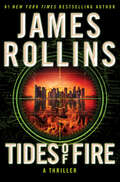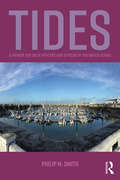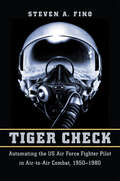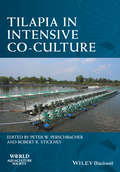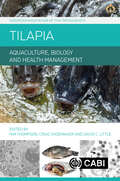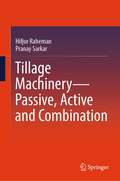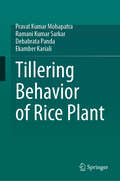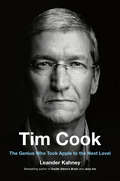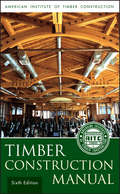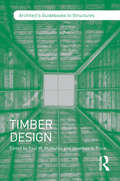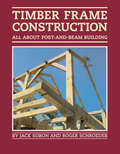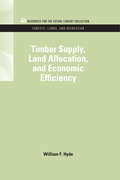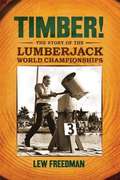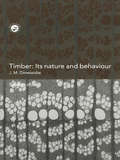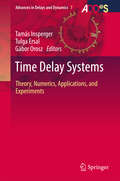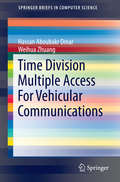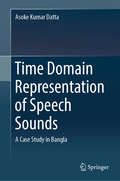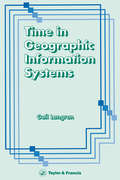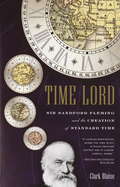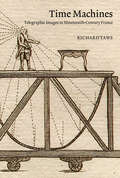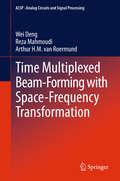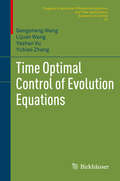- Table View
- List View
Tides of Fire: A Sigma Force Novel (Sigma Force #17)
by James RollinsIn the latest riveting thriller from James Rollins, the #1 New York Times bestselling author of the Sigma Force series, an international research station in the Coral Sea comes under siege during a geological disaster that triggers massive quakes, deadly tsunamis, and volcanic eruptions. To stop the world from burning, it’s up to Sigma Force to uncover a secret buried at the heart of our planet. The Titan Project—an international research station off the coast of Australia—discovers a thriving zone of life in an otherwise dead sea. The area teems with a strange bioluminescent coral that defies science, yet holds great promise for the future. But the loss of a military submarine in the area triggers a brutal attack and sets in motion a geological disaster that destabilizes an entire region.Massive quakes, volcanic eruptions, and deadly tsunamis herald a greater cataclysm to come—for something is stirring miles under the ocean, a threat hidden for millennia.As seas turn toxic and coastlines burn, can Sigma Force stop what has been let loose—especially as an old adversary returns, hunting them and thwarting their every move? For any hope of success, Commander Gray Pierce must search for a key buried in the past, hidden deep in Aboriginal mythology. But what Sigma could uncover is even more frightening—something that will shake the very foundations of humanity.
Tides: A Primer for Deck Officers and Officer of the Watch Exams
by Philip M. SmithTides: A Primer for Deck Officers and Officer of the Watch Exams prepares the reader for the Officer of the Watch and Master/Mate certificates required by all officers on commercial seagoing vessels. From the formation of tides and tidal stream data, right through to practice questions with answers, and even mock exam papers, this book will provide you with all the reference material you need in order to pass your exams.
Tiger Check: Automating the US Air Force Fighter Pilot in Air-to-Air Combat, 1950–1980
by Steven A. FinoHow did American fighter pilots respond to the challenges posed by increasing automation?Spurred by their commanders during the Korean War to be "tigers," aggressive and tenacious American fighter pilots charged headlong into packs of fireball-spewing enemy MiGs, relying on their keen eyesight, piloting finesse, and steady trigger fingers to achieve victory. But by the 1980s, American fighter pilots vanquished their foes by focusing on a four-inch-square cockpit display, manipulating electromagnetic waves, and launching rocket-propelled guided missiles from miles away. In this new era of automated, long-range air combat, can fighter pilots still be considered tigers? Aimed at scholars of technology and airpower aficionados alike, Steven A. Fino’s Tiger Check offers a detailed study of air-to-air combat focusing on three of the US Air Force’s most famed aircraft: the F-86E Sabre, the F-4C Phantom II, and the F-15A Eagle. Fino argues that increasing fire control automation altered what fighter pilots actually did during air-to-air combat. Drawing on an array of sources, as well as his own decade of experience as an F-15C fighter pilot, Fino unpacks not just the technological black box of fighter fire control equipment, but also fighter pilots’ attitudes toward their profession and their evolving aircraft. He describes how pilots grappled with the new technologies, acutely aware that the very systems that promised to simplify their jobs while increasing their lethality in the air also threatened to rob them of the quintessential—albeit mythic—fighter pilot experience. Finally, Fino explains that these new systems often required new, unique skills that took time for the pilots to identify and then develop. Eschewing the typical "great machine" or "great pilot" perspectives that dominate aviation historiography, Tiger Check provides a richer perspective on humans and machines working and evolving together in the air. The book illuminates the complex interactions between human and machine that accompany advancing automation in the workplace.
Tilapia in Intensive Co-culture
by Robert R. Stickney Peter PerschbacherIntensive tilapia co-culture is the commercial production of various species of tilapia in conjunction with one or more other marketable species. Tilapia are attractive as a co-cultured fish because of their potential to improve water quality, especially in penaeid shrimp ponds, by consuming plankton and detritus and by altering pathogenic bacterial populations while increasing marketable production. Following introductory chapters covering ecological aspects of co-culture, tilapia feeding habits, historical use, and new models, Tilapia in Intensive Co-Culture is divided into co-culture in freshwater and marine environments. Co-culture core information is presented on Vibrio control, high-rate aquaculture processes, aquaponics, tilapia nutrient profile, and tilapia niche economics and marketing in the U.S, and with carp, catfish, freshwater and marine shrimp in the Americas, the Middle East, and Asia. Tilapia in Intensive Co-Culture is the latest book in the prestigious World Aquaculture Society (WAS) Series, published for WAS by Wiley Blackwell. It will be of great use and interest to researchers, producers, investors and policy makers considering tilapia co-culture in terms of environmental and economic sustainability.
Tilapia: Aquaculture, Biology and Health Management (European Association of Fish Pathologists (EAFP))
by Kim Thompson, Craig Shoemaker & David C. LittleTilapia are a group of cichlid fish endemic to tropical freshwater in Africa, Jordan and Israel, that are extremely nutritious and in high global demand. They are a popular species to farm because of their relative ease of culture, their tolerance to relatively high stocking densities, large size, rapid growth and palatability. As a thorough exploration of tilapia aquaculture, this book emphasizes the significance of this group of fish and discusses the crucial elements of tilapia farming, including their reproductive and genetic characteristics, the various cultivation systems employed and the emerging governance of the practice. It also addresses important health management issues, focusing on nutrition, immunology, and animal welfare and extensively analyses the diseases that afflict tilapia, how they are diagnosed and what potential zoonotic hazards exist. The value of the book includes: Contributing to the wider understanding of tilapia aquaculture and the importance of the species to global food security. Providing an in-depth discussion on tilapia fish health, including major diseases, nutrition, immunology and disease prevention. Giving detailed insights into tilapia genetics, production systems, and reproduction. Written by an international team of experts to advance the long-term, sustainable growth of the global aquaculture industry, this book is a comprehensive and essential resource for anyone involved in or learning about tilapia farming.
Tillage Machinery—Passive, Active and Combination
by Hifjur Raheman Pranay SarkarThis textbook comprehensively covers the fundamental concepts of tillage operation, including all the three kinds of tillage implements, viz. passive, active and combination. It discusses functional analysis, principle of operation, and testing of main tillage machinery. This textbook includes the design procedure and numerical examples to reinforce the theoretical concepts. It incorporates a lucid style of writing with easy-to-understand design procedure of different tillage implements. This textbook is highly useful for graduate and postgraduate students studying farm machinery and power engineering, design of agricultural machines, and allied fields.
Tillering Behavior of Rice Plant
by Pravat Kumar Mohapatra Ramani Kumar Sarkar Debabrata Panda Ekamber KarialiThis authored volume highlights the concern for food security of Asian nations traditionally focused on rice. Rice grain is a complex carbohydrate used as a primary food energy source. This book focuses on the impact of high-rise consumer demand on accelerating grain production and ensuring societal stability. Wide coverage is given to variation in rice cultivation under unstable and sharply differing environments, where soil moisture level dictates plant phenology exaggerating tillering dynamics. The book provides essential information for environment-specific regulation of plant growth, tiller number, growth pattern, and manipulation of tiller dynamics for yield. Authors have also elucidated molecular biology underlying tiller survival, the origin of rice and factors crucial for evolutionary change of plant type devoted to imaging a designer plant type. The book includes topics on the ecology of rice environment, cultural types, ontogeny of tiller formation, tiller classes, genetic control of tillering and physiology of tiller growth. A comprehensive account of tiller dynamics resilient to climate change helps students and researchers learn and gain skills to achieve optimum rice yield. This book is important to students, teachers, researchers and climate change scientists. Further, it serves in designing and shaping rice production in the disintegrating rice agroecosystem under the impact of climate change.
Tim Cook: The Genius Who Took Apple to the Next Level
by Leander KahneyJournalist Leander Kahney reveals how CEO Tim Cook has led Apple to astronomical success after the death of Steve Jobs in 2011. The death of Steve Jobs left a gaping void at one of the most innovative companies of all time. Jobs wasn't merely Apple's iconic founder and CEO; he was the living embodiment of a global megabrand. It was hard to imagine that anyone could fill his shoes--especially not Tim Cook, the intensely private executive who many thought of as Apple's "operations drone."But seven years later, as journalist Leander Kahney reveals in this definitive book, things at Apple couldn't be better. Its stock has nearly tripled, making it the world's first trillion dollar company. Under Cook's principled leadership, Apple is pushing hard into renewable energy, labor and environmentally-friendly supply chains, user privacy, and highly-recyclable products. From the massive growth of the iPhone to lesser-known victories like the Apple Watch, Cook is leading Apple to a new era of success.Drawing on access with several Apple insiders, Kahney tells the inspiring story of how one man attempted to replace someone irreplacable, and--through strong, humane leadership, supply chain savvy, and a commitment to his values--succeeded more than anyone had thought possible.
Timber Bridges
by Christopher MettemBridges built in timber are enjoying a significant revival, both for pedestrian and light traffic and increasingly for heavier loadings and longer spans. Timber's high strength-to-weight ratio, combined with the ease and speed of construction inherent in the off-site prefabrication methods used, make a timber bridge a suitable option in many different scenarios.This handbook gives technical guidance on forms, materials, structural design and construction techniques suitable for both small and large timber bridges. Eurocode 5 Part Two (BS EN 1995-2) for the first time provides an international standard for the construction of timber bridges, removing a potential obstacle for engineers where timber construction for bridges has not – in recent centuries at least – been usual.Clearly illustrated throughout, this guide explains how to make use of this oldest construction material in a modern context to create sustainable, aesthetically pleasing, practical and durable bridges. Worldwide examples include Tourand Creek Bridge, Canada; Toijala, Finland; Punt la Resgia, Switzerland; Pont de Crest, France; Almorere Pylon Bridge, the Netherlands.
Timber Connections: Mortise and Tenon Structural Design (SpringerBriefs in Applied Sciences and Technology)
by Rohana Hassan Zakiah Ahmad Azmi IbrahimThis book describes the application of mathematical and fundamental theory as stated in the relevant standards, namely EYM and NDS. Timber is one of the important building materials in the field of engineering, other than concrete and steel. However, there is still a lot of unexplored knowledge about timber, including how timber connections are made. One of the main types of timber connection is mortise and tenon. Mortise and tenon are widely seen as one of the most important traditional timber structural joint. In order to understand the load-carrying capacity and performance of the structural mortise and tenon joint, the existing theoretical background of timber joint design is made as a reference. Current equations applicable in estimating the load-carrying capacity of timber joint uses the European Yield Model (EYM). Therefore, the main aim of this book is to share the basic design knowledge, inclusive of safety factor limitations (as engineering main factor) in structural design.
Timber Construction Manual
by Jeff D. Linville American Institute of Timber ConstructionThe definitive design and construction industry source for building with wood-now in a thoroughly updated Sixth EditionSince its first publication in 1966, Timber Construction Manual has become the essential design and construction industry resource for building with structural glued laminated timber. Timber Construction Manual, Sixth Edition provides architects, engineers, contractors, educators, and related professionals with up-to-date information on engineered timber construction, including the latest codes, construction methods, and authoritative design recommendations. Content has been reorganized to flow easily from information on wood properties and applications to specific design considerations.Based on the most reliable technical data available, this edition has been thoroughly revised to encompass:A thorough update of all recommended design criteria for timber structural members, systems, and connectionsAn expanded collection of real-world design examples supported with detailed schematic drawingsNew material on the role of glulam in sustainable building practicesThe latest design and construction codes, including the 2012 National Design Specification for Wood Construction, AITC 117-2010, and examples featuring ASCE 7-10 and IBC 2009More cross-referencing to other available AITC standards on the AITC website
Timber Design (Architect's Guidebooks to Structures)
by Paul W. McMullin Jonathan S. PriceTimber Design covers timber fundamentals for students and professional architects and engineers, such as tension elements, flexural elements, shear and torsion, compression elements, connections, and lateral design. As part of the Architect’s Guidebooks to Structures series, it provides a comprehensive overview using both imperial and metric units of measurement. Timber Design begins with an intriguing case study and uses a range of examples and visual aids, including more than 200 figures, to illustrate key concepts. As a compact summary of fundamental ideas, it is ideal for anyone needing a quick guide to timber design.
Timber Frame Construction: All About Post-and-Beam Building
by Jack A. Sobon Roger SchroederDiscover the satisfaction of making your own durable, economical, and environmentally friendly timber frame structures. Covering all aspects of timber frame construction, this practical guide is filled with easy-to-understand instructions, clear illustrations, and helpful photographs. With expert advice on selecting appropriate timber, necessary tools, safety considerations, joinery techniques, assembly, and raising, Jack Sobon and Roger Schroeder encourage beginners by offering complete plans for a small toolshed. Turn your dream of a timber frame house into a reality.
Timber Supply, Land Allocation, and Economic Efficiency: Timber Supply, Land Allocation, And Economic Efficiency (RFF Forests, Lands, and Recreation Set)
by William F. HydeFirst Published in 2011. Routledge is an imprint of Taylor & Francis, an informa company.
Timber!
by Lew FreedmanEach summer, men and women travel from all over the globe to the Lumberjack World Championships in Hayward, Wisconsin, to compete before thousands of spectators and prove who is the best at chopping and sawing wood, log rolling, and boom running. The event, with its impressive international fan base, has become the most prestigious timber sport gathering in the world. Timber!chronicles the history of the championships since its inception in 1960 and highlights such popular athletes as J. R. Salzman, Ron Hartill, and Peggy Halvorson, all of whom are stalwarts in a variety of events from the hot saw to the springboard chop. These glory-seeking competitors symbolize a connection to the old days of logging in Wisconsin and throughout the United States, when timber-felling helped build the country. Lively and informative,Timber!shows how these timber sports keep alive the spirit of the logging world and the image of the logger as an American pioneer.
Timber: Its Nature and Behaviour
by J.M. DinwoodieTimber: Its Nature and Behaviour adopts a materials science approach to timber and comprehensively examines the relationship between the performance of timber and its structure. This book explains a wide range of timbers physical and mechanical behaviour (including processing) in terms of its basic structure and its complex interaction with moisture. The performance of timber and panel products is also related to the levels set in new European specifications and with the associated methods of testing.
Time Delay Systems
by Tamás Insperger Tulga Ersal Gábor OroszThis volume collects contributions related to selected presentations from the 12th IFAC Workshop on Time Delay Systems, Ann Arbor, June 28-30, 2015. The included papers present novel techniques and new results of delayed dynamical systems. The topical spectrum covers control theory, numerical analysis, engineering and biological applications as well as experiments and case studies. The target audience primarily comprises research experts in the field of time delay systems, but the book may also be beneficial for graduate students alike.
Time Dependent Phase Space Filters: A Stable Absorbing Boundary Condition (SpringerBriefs on PDEs and Data Science)
by Minh-Binh Tran Avy Soffer Chris StucchioThis book introduces an interesting and alternative way to design absorbing boundary conditions (ABCs) for quantum wave equations, basically the nonlinear Schrödinger equation. The focus of this book is the application of the phase space filter approach to derive accurate radiation conditions for Schrödinger equations.Researchers who are interested in partial differential equations and mathematical physics might find this book appealing.
Time Division Multiple Access For Vehicular Communications
by Weihua Zhuang Hassan Aboubakr OmarThis brief focuses on medium access control (MAC) in vehicular ad hoc networks (VANETs), and presents VeMAC, a novel MAC scheme based on distributed time division multiple access (TDMA) for VANETs. The performance of VeMAC is evaluated via mathematical analysis and computer simulations in comparison with other existing MAC protocols, including the IEEE 802. 11p standard. This brief aims at proposing TDMA as a suitable MAC scheme for VANETs, which can support the quality-of-service requirements of high priority VANET applications.
Time Domain Representation of Speech Sounds: A Case Study In Bangla
by Asoke Kumar DattaThe book presents the history of time-domain representation and the extent of its development along with that of spectral domain representation in the cognitive and technology domains. It discusses all the cognitive experiments related to this development, along with details of technological developments related to both automatic speech recognition (ASR) and text to speech synthesis (TTS), and introduces a viable time-domain representation for both objective and subjective analysis, as an alternative to the well-known spectral representation.The book also includes a new cohort study on the use of lexical knowledge in ASR. India has numerous official dialects, and spoken-language technology development is a burgeoning area. In fact TTS and ASR taken together constitute the most important technology for empowering people. As such, the book describes time domain representation in such a way that it can be easily and seamlessly incorporated into ASR and TTS research and development. In short, it is a valuable guidebook for the development of ASR and TTS in all the Indian Standard Dialects using signal domain parameters.
Time In Geographic Information Systems (Technical Issues In Gis Ser.)
by Gail KuceraA study into the consideration of the temporal dimension of computerized spatial data handling using GIS. The book describes the use of historical and time-variable data as explicit components of the modelling process.
Time Lord
by Clark BlaiseIt is difficult today to imagine life before standard time was established in 1884. In the middle of the nineteenth century, for example, there were 144 official time zones in North America alone. The confusion that ensued, especially among the burgeoning railroad companies, was an hourly comedy of errors that ultimately threatened to impede progress. The creation of standard time, with its two dozen global time zones, is one of the great inventions of the Victorian Era, yet it has been largely taken for granted.In Time Lord, Clark Blaise re-creates the life of Sanford Fleming, who struggled to convince the world to accept standard time. It's a fascinating story of science, politics, nationalism, and the determined vision of one man who changed the world. Set in a time marked by substantial technological and cultural transformation, Time Lord is also an erudite exploration of art, literature, consciousness, and our changing relationship to timeFrom the Trade Paperback edition.
Time Machines: Telegraphic Images in Nineteenth-Century France
by Richard TawsA riveting exploration of the relationship between art and telegraphy, and its implications for understanding time and history in nineteenth-century France.In Time Machines Richard Taws examines the relationship between art and telegraphy in the decades following the French Revolution. The optical telegraph was a novel form of visual communication developed in the 1790s that remained in use until the mid-1850s. This pre-electric telegraph, based on a semaphore code, irrevocably changed the media landscape of nineteenth-century France. Although now largely forgotten, in its day it covered vast distances and changed the way people thought about time. It also shaped, and was shaped by, a proliferating world of images. What happens, Taws asks, if we think about art telegraphically?Placed on prominent buildings across France—for several years there was one on top of the Louvre—the telegraph’s waving limbs were a ubiquitous sight, shifting how public space was experienced and represented. The system was depicted by a wide range of artists, who were variously amused, appalled, irritated, or seduced by the telegraph’s intractable coded messages and the uncanny environmental and perceptual disruption it caused. Clouds, architecture, landscapes, and gestures: all signified differently in the era of telegraphy, and the telegraph became a powerful means to comprehend France’s technological and political past. While Paris’s famous arcades began to crisscross the city at ground level, a more enigmatic network was operating above. Shifting attention from the streets to the skies, this book shows how modern France took shape quite literally under the telegraph’s sign.
Time Multiplexed Beam-Forming with Space-Frequency Transformation
by Reza Mahmoudi Arthur H.M. van Roermund Wei DengThis book describes a unique approach to smart receiver system design. It starts with the analysis of a very basic, single-path receiver structure, then using similar methods, extends the analysis to a more complicated multi-path receiver. Within the multi-path structure, two different types of phased -array architectures are discussed: Analog beam-forming, and digital beam-forming. The pros and cons are studied, and the gaps are identified. Whereas previous books in this area focus mainly on phased-array circuit implementations, this book fills a gap by providing a system-level approach and introduces new methods for developing smart systems.
Time Optimal Control of Evolution Equations (Progress in Nonlinear Differential Equations and Their Applications #92)
by Gengsheng Wang Yashan Xu Lijuan Wang Yubiao ZhangThis monograph develops a framework for time-optimal control problems, focusing on minimal and maximal time-optimal controls for linear-controlled evolution equations. Its use in optimal control provides a welcome update to Fattorini’s work on time-optimal and norm-optimal control problems. By discussing the best way of representing various control problems and equivalence among them, this systematic study gives readers the tools they need to solve practical problems in control. After introducing preliminaries in functional analysis, evolution equations, and controllability and observability estimates, the authors present their time-optimal control framework, which consists of four elements: a controlled system, a control constraint set, a starting set, and an ending set. From there, they use their framework to address areas of recent development in time-optimal control, including the existence of admissible controls and optimal controls, Pontryagin’s maximum principle for optimal controls, the equivalence of different optimal control problems, and bang-bang properties.This monograph will appeal to researchers and graduate students in time-optimal control theory, as well as related areas of controllability and dynamic programming. For ease of reference, the text itself is self-contained on the topic of time-optimal control. Frequent examples throughout clarify the applications of theorems and definitions, although experience with functional analysis and differential equations will be useful.
